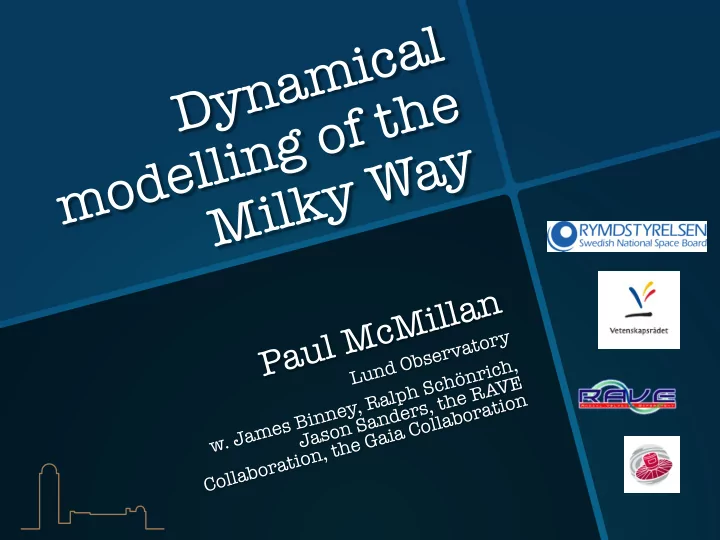

Dynamical modelling of the Milky Way Paul McMillan y r o t a v r e s b O , h d c n i r u L n ö h E c V S A h R p l e a h n R t o i , , t y s a r e r n e d o n b n i a B a l S l s o e n C m o a s a i a a J J G . w e h t , n o i t a r o b a l l o C
The Problem It’s so slow…
Can’t measure the acceleration s t n Can measure positions e m and velocities e r u s a e M For billions of stars…
Need a model to find gravitational field from the Great observations data needs a great model Stars move, but the distribution (density profile, velocity distribution) stays the same
Action- angle coordinates McMillan & Binney 2008 Binney 2012 Model orbits Binney & McMillan 2016 Bovy 2015
What can action-angle modelling do for you?
Gravitational f ield (Dark matter)
Many different techniques. Some mostly Galactic k y r plane (e.g., McMillan 2011, t a i 2017) s d n github.com/PaulMcMillan-Astro/GalPot e e h d t Some mostly r d e perpendicular (e.g., n t Garbari et al. 2012) i t F a m (see Read 2014 for a review)
Global approach (Piffl et al 2014) k y r t a i s d n e e h d t r d e n t i t F a m
C h e m o d y n a m i c s
Understanding chemical evolution Old – Type-II SN enrichment Younger – Type Ia SN enrichment Wojno et al 2016 (see also Lee et al 2011)
Explained by a dynamical model and inside-out formation (Schönrich & McMillan 2017)
Metal poor gas Metal rich gas Metal poor young stars Metal rich young stars M e t a l l i c i t y g (Galaxy picture, r McMillan priv comm) a d i e n t s
Natural explanation for (younger) lower- α stars From R>R 0 From R<R 0
How does it get reversed for high α ? Inside-out formation
[ Fe/H ] t = 2 Gyr t ≈ 0 R Inside out formation
But also: asymmetric drift � (high vel. disp. = velocity lag) If two populations v φ at R 0 have the same If low [Fe/H] mean radius has higher vel. (i.e. there is disp. (e.g. no radial because it’s metallicity older) gradient) and velocity dispersion [ Fe/H ]
Velocity Substructure
Real data y e t r i c u o t Smooth l c e model u V r t s b u Dehnen (1999) (see also Kushniruk et al 2017) s Modelled by: Sellwood 2010, McMillan 2011, 2013, Monari et al 2016
Action-angle coordinates are a toolset for understanding galaxy s dynamics n o i We can find the s u gravitational potential, l understand chemical c n evolution, and the effect of o the spirals/bar C Data are coming! Thank you!
B l a n k s l i d e
The α -Fe plane Bensby, Feltzing, Oey 2014
The α -Fe plane Wojno et al 2016
H e l m i ’ s s t r e a m
Gaia data is an incredible opportunity to understand a galaxy d l (actually several…) o e o d g o Need a model to find m gravitational field from the a observations d e e n e W
Found in many surveys. From the field of streams… (Belokurov et al 2006) to DES (Shipp et al 2018) Streams do not follow orbits (see poster)
Gaia data is an incredible opportunity to understand d l a galaxy o e (actually several…) o d g o m Need a model to find a gravitational field from the d observations e e n e W
Recommend
More recommend